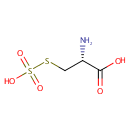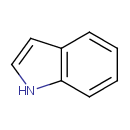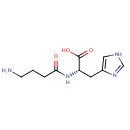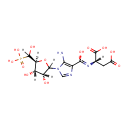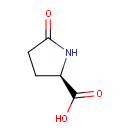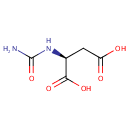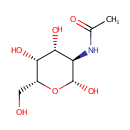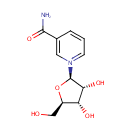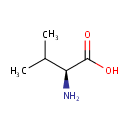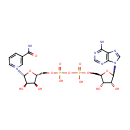
Search Results for compounds
Searching compounds for
returned 4373 results.
Cysteine-S-sulfate (PAMDB000180)
IUPAC:
(2R)-2-amino-3-(sulfosulfanyl)propanoic acid
CAS: 1637-71-4
Description: Cysteine-S-sulfate (SSC) is produced by reaction of inorganic sulfite and cystine by a yet unknown pathway and is a very potent NMDA-receptor agonist. Electrophysiological studies have shown that SSC displays depolarizing properties similar to glutamate. It is an intermediate of cysteine and methionine metabolism.
Indole (PAMDB000181)
IUPAC:
1H-indole
CAS: 120-72-9
Description: Indole is an aromatic heterocyclic organic compound. It has a bicyclic structure, consisting of a six-membered benzene ring fused to a five-membered nitrogen-containing pyrrole ring. It can be produced by bacteria as a degradation product of the amino acid tryptophan. It occurs naturally in feces and has an intense fecal smell. At very low concentrations, however, it has a flowery smell, and is a constituent of many flower scents (such as orange blossoms) and perfumes. Natural jasmine oil, used in the perfume industry, contains around 2.5% of indole. Indole also occurs in CoAl tar. The participation of the nitrogen lone electron pair in the aromatic ring means that indole is not a base, and it does not behave like a simple amine.
Homocarnosine (PAMDB000182)
IUPAC:
(2S)-2-(4-aminobutanamido)-3-(1H-imidazol-4-yl)propanoic acid
CAS: 3650-73-5
Description: Homocarnosine is an intermediate of arginine and proline metabolism. tis converted from 4-amino-butanoate via aminoacylhistidine dipeptidase. It consists of gamma-aminobutyric acid and histidine.
SAICAR (PAMDB000186)
IUPAC:
(2S)-2-[({5-amino-1-[(3R,4S,5S)-3,4-dihydroxy-5-[hydroxy(phosphono)methyl]oxolan-2-yl]-1H-imidazol-4-yl}(hydroxy)methylidene)amino]butanedioic acid
CAS: 3031-95-6
Description: SAICAR (or (S)-2-[5-Amino-1-(5-phospho-D-ribosyl)imidazole-4-carboxamido]succinate) is a substrate for the multifunctional protein ADE2. SAICAR is an intermediate in purine metabolism. (S)-2-[5-Amino-1-(5-phospho-D-ribosyl)imidazole-4-carboxamido]succinate is converted from 5-Amino-1-(5-phospho-D-ribosyl) imidazole-4-carboxylate via phosphoribosylaminoimidazole-succinocarboxamide synthase [EC: 6.3.2.6] or SAICAR synthase. This enzyme catalyses the seventh step out of ten in the biosynthesis of purine nucleotides. (Wikipedia)
Pyrrolidonecarboxylic acid (PAMDB000187)
IUPAC:
(2R)-5-oxopyrrolidine-2-carboxylic acid
CAS: 4042-36-8
Description: Pyrrolidonecarboxylic acid is a member of the chemical class known as Pyrrolidine Carboxylic Acids and Derivatives. These are compounds containing a pyrrolidine ring which bears a carboxylic acid or a derivative thereof. 2-Pyrrolidone-5-carboxylic acid (PCA) is a cyclic derivative of glutamic acid, and has been found in Pseudomonas aeruginosa beta-galactosidase. It is produced by gamma-glutamyl phosphate reductase (glutamate semialdehyde dehydrogenase) via glutamic acid 5-semidaldehyde [PMID: 7034716].
Ureidosuccinic acid (PAMDB000189)
IUPAC:
(2S)-2-(carbamoylamino)butanedioic acid
CAS: 13184-27-5
Description: Ureidosuccinic acid is an intermediary product in pyrimidine metabolism. It is generated by the action of dihydroorotase which catalyzes the following reaction: 4,5-Dihydroorotic acid + Water <=> Ureidosuccinic acid + H+
N-Acetyl-b-D-galactosamine (PAMDB000193)
IUPAC:
N-[(2R,3R,4R,5R,6R)-2,4,5-trihydroxy-6-(hydroxymethyl)oxan-3-yl]acetamide
CAS: 14131-60-3
Description: N-Acetyl-b-D-galactosamine is one of the eight essential sugars. It is important for cell communication. In galactose metabolism pathway, it is converted to N-Acetyl-b-D-galactosamine-6P by N-acetylgalactosamine-specific phosphotransferase enzyme B (EC 2.7.1.69).
Nicotinamide riboside (PAMDB000194)
IUPAC:
3-carbamoyl-1-[(2R,3R,4S,5R)-3,4-dihydroxy-5-(hydroxymethyl)oxolan-2-yl]-1???pyridin-1-ylium
CAS: 1341-23-7
Description: Nicotinamide riboside is involved in nicotinate and nicotinamide metabolism. It is a reducible moiety of the coenzyme NAD+. Nicotinamide riboside kinase has an essential role for phosphorylation of nicotinamide riboside (PMID 15137942).
L-Valine (PAMDB000196)
IUPAC:
(2S)-2-amino-3-methylbutanoic acid
CAS: 72-18-4
Description: Valine is an alpha-amino acid with the chemical formula HO2CCH(NH2)CH(CH3)2. L-Valine is one of 20 proteinogenic amino acids. Its codons are GUU, GUC, GUA, and GUG. This amino acid is classified as nonpolar. Along with leucine and isoleucine, valine is a branched-chain amino acid. It is named after the plant valerian. (Wikipedia)
NAD (PAMDB000197)
IUPAC:
1-[(2R,3R,4S,5R)-5-[({[({[(2R,3S,4R,5R)-5-(6-amino-9H-purin-9-yl)-3,4-dihydroxyoxolan-2-yl]methoxy}(hydroxy)phosphoryl)oxy](hydroxy)phosphoryl}oxy)methyl]-3,4-dihydroxyoxolan-2-yl]-3-carbamoyl-1???pyridin-1-ylium
CAS: 53-84-9
Description: NAD (or Nicotinamide adenine dinucleotide) is used extensively in glycolysis and the citric acid cycle of cellular respiration. The reducing potential stored in NADH can be converted to ATP through the electron transport chain or used for anabolic metabolism. ATP "energy" is necessary for an organism to live. Green plants obtain ATP through photosynthesis, while other organisms obtain it by cellular respiration. (wikipedia). Nicotinamide adenine dinucleotide is a A coenzyme composed of ribosylnicotinamide 5'-diphosphate coupled to adenosine 5'-phosphate by pyrophosphate linkage. It is found widely in nature and is involved in numerous enzymatic reactions in which it serves as an electron carrier by being alternately oxidized (NAD+) and reduced (NADH). (Dorland, 27th ed)
